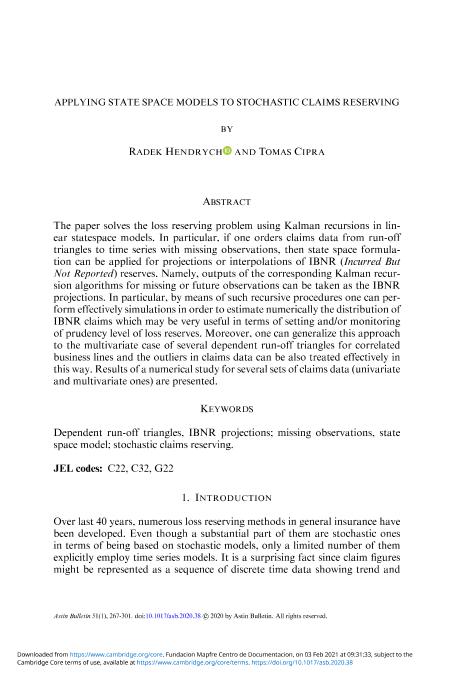Applying state space models to stochastic claims reserving

Contenido multimedia no disponible por derechos de autor o por acceso restringido. Contacte con la institución para más información.
| Tag | 1 | 2 | Valor |
|---|---|---|---|
| LDR | 00000cab a2200000 4500 | ||
| 001 | MAP20210005541 | ||
| 003 | MAP | ||
| 005 | 20210219145554.0 | ||
| 008 | 210219e20210101bel|||p |0|||b|eng d | ||
| 040 | $aMAP$bspa$dMAP | ||
| 084 | $a6 | ||
| 100 | $0MAPA20210003127$aHendrych, Radek | ||
| 245 | 1 | 0 | $aApplying state space models to stochastic claims reserving$cRadek Hendrych, Tomas Cipra |
| 520 | $aThe paper solves the loss reserving problem using Kalman recursions in linear statespace models. In particular, if one orders claims data from run-off triangles to time series with missing observations, then state space formulation can be applied for projections or interpolations of IBNR (Incurred But Not Reported) reserves. Namely, outputs of the corresponding Kalman recursion algorithms for missing or future observations can be taken as the IBNR projections. In particular, by means of such recursive procedures one can perform effectively simulations in order to estimate numerically the distribution of IBNR claims which may be very useful in terms of setting and/or monitoring of prudency level of loss reserves. Moreover, one can generalize this approach to the multivariate case of several dependent run-off triangles for correlated business lines and the outliers in claims data can be also treated effectively in this way. Results of a numerical study for several sets of claims data (univariate and multivariate ones) are presented. | ||
| 650 | 4 | $0MAPA20080586447$aModelo estocástico | |
| 650 | 4 | $0MAPA20080553128$aAlgoritmos | |
| 650 | 4 | $0MAPA20080579258$aCálculo actuarial | |
| 700 | 1 | $0MAPA20210003134$aCipra, Tomas | |
| 773 | 0 | $wMAP20077000420$tAstin bulletin$dBelgium : ASTIN and AFIR Sections of the International Actuarial Association$x0515-0361$g01/01/2021 Volumen 51 Número 1 - enero 2021 , p. 267-301 |

